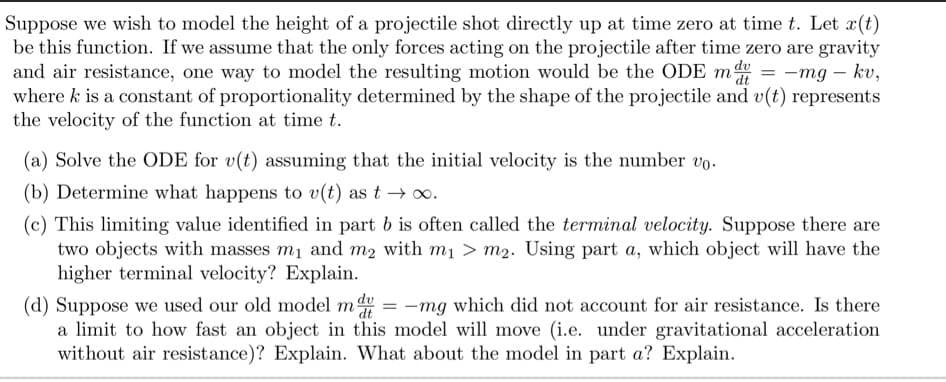uppose we wish to model the height of a projectile shot directly up at time zero at time t. Let x(t) be this function. If we assume that the only forces acting on the projectile after time zero are gravity and air resistance, one way to model the resulting motion would be the ODE m = -mg – kv, where k is a constant of proportionality determined by the shape of the projectile and v(t) represents the velocity of the function at time t.
uppose we wish to model the height of a projectile shot directly up at time zero at time t. Let x(t) be this function. If we assume that the only forces acting on the projectile after time zero are gravity and air resistance, one way to model the resulting motion would be the ODE m = -mg – kv, where k is a constant of proportionality determined by the shape of the projectile and v(t) represents the velocity of the function at time t.
Algebra & Trigonometry with Analytic Geometry
13th Edition
ISBN:9781133382119
Author:Swokowski
Publisher:Swokowski
Chapter5: Inverse, Exponential, And Logarithmic Functions
Section: Chapter Questions
Problem 18T
Related questions
Question
Please help ASAP

Transcribed Image Text:Suppose we wish to model the height of a projectile shot directly up at time zero at time t. Let x(t)
be this function. If we assume that the only forces acting on the projectile after time zero are gravity
and air resistance, one way to model the resulting motion would be the ODE m = -mg – kv,
where k is a constant of proportionality determined by the shape of the projectile and v(t) represents
the velocity of the function at time t.
(a) Solve the ODE for v(t) assuming that the initial velocity is the number vo.
(b) Determine what happens to v(t) as t → .
(c) This limiting value identified in part b is often called the terminal velocity. Suppose there are
two objects with masses m1 and m2 with m1 > m2. Using part a, which object will have the
higher terminal velocity? Explain.
(d) Suppose we used our old model m de
a limit to how fast an object in this model will move (i.e. under gravitational acceleration
without air resistance)? Explain. What about the model in part a? Explain.
-mg which did not account for air resistance. Is there
Expert Solution
This question has been solved!
Explore an expertly crafted, step-by-step solution for a thorough understanding of key concepts.
Step by step
Solved in 2 steps with 1 images

Recommended textbooks for you

Algebra & Trigonometry with Analytic Geometry
Algebra
ISBN:
9781133382119
Author:
Swokowski
Publisher:
Cengage

College Algebra (MindTap Course List)
Algebra
ISBN:
9781305652231
Author:
R. David Gustafson, Jeff Hughes
Publisher:
Cengage Learning

Algebra & Trigonometry with Analytic Geometry
Algebra
ISBN:
9781133382119
Author:
Swokowski
Publisher:
Cengage

College Algebra (MindTap Course List)
Algebra
ISBN:
9781305652231
Author:
R. David Gustafson, Jeff Hughes
Publisher:
Cengage Learning